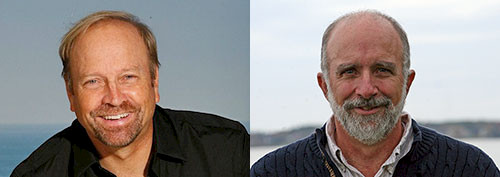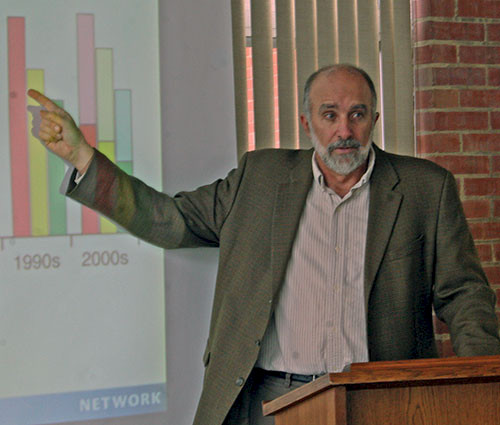Presentation dialog
Bill Dennison ·Bill has important scientific data AND it is highly relevant BUT he is boring the audience THEREFORE Randy interrupts to improve Bill's presentation...
Following the science communication session at the CERF 2013 conference, I was inspired to write this script of an imaginary conversation between me and Randy Olson. I know Randy from when we were graduate students (I was at The University of Chicago and Randy was at Harvard University), and then our lives continued to interweave between back-to-back underwater habitat missions, living in Australia and studying the Great Barrier Reef. We also have had convergent journeys of developing a passion for communicating science, Randy from outside academia and me from within academia.

Setting: A hotel conference center room, with Bill standing behind a podium using a laser pointer clicking through PowerPoint slides to a bored audience and Randy sitting in the back of the audience.
Bill (Presenter): If you look here, you can see that the trend in this graph shows...
Randy (in the audience): Hey this is boring!
Bill: Excuse me?
Randy: You heard me, boooooooriiiiiiiing.
B: Look I have some important things to say and I only have 15 min, so why don't you shut up and let me get my point across.
R: Why should I listen to you babble on and put everyone asleep?
B: Well let me do a poll, who in the audience is awake? There, you see, everyone here is awake and listening.
R: They are only listening because you quit showing those awful PowerPoint slides and started talking to me.
B: What is wrong with my PowerPoint slides?
R: Where do I start? I cannot read the axes, the title doesn't tell me anything relevant, all the text distracts from what you were saying.
B: So what, my PowerPoint slides could be improved, I still have important things to say and I have another ten minutes to say them.
R: Well, why don't you turn the PowerPoint off and just talk to us?
B: But I need my PowerPoint slides to get my message across.
R: If we can't even read your graphs and you spend all your time looking at the slide, pointing at things on the slide, and we can just read your stupid dot points, why bother?
B: I use PowerPoint to organize my thoughts and pace my talk.
R: What would happen if you just used some notes and talked to us?
B: I have not practiced doing that.
R: I will help, here turn this off. Now what is your most important message?
B: Well, let's see, I was going to tell everyone how we established that there is a global decline in seagrasses.
R: How big a decline?
B: I'm not sure I can remember, I need my PowerPoint.
R: Why are you even talking about this subject if you don't have a clue what you're talking about?
B: All right, I will tell you if you will just let me explain.
R: Go ahead.
B: Well, I write important scientific papers for peer review journals by writing an abstract, introduction, methods, results, discussion, conclusions and scientific references. Answering your question is well, science communication, and it's, well, different. Lots of pretty pictures, you know dumbed down for non scientists.
R: That is the stupidest thing I have ever heard. Dumbed down with photos? Who do you think you are communicating science to? Morons?
B: Look, I have a bachelors degree, a Master's degree and a PhD. I even did a post doc. I spent years and years studying seagrasses. So I am a seagrass expert and I do lots of complicated experiments so that I can understand nature. I have to take this complicated knowledge and convert it to something that everyone understands. I can use small words and show photos.
R: But you don't think that the people are plenty smart, that all they need is synthesized results, some good visualizations, and the context of the science they are viewing without all the jargon you scientists use?
B: Do you really think that synthesis, visualization and context is all that is needed? Science is very complicated stuff.
R: Is it really complicated? Are the questions you are asking really all that complicated? The technology and analyses may be complicated, but aren't you just asking and answering some basic questions?
B: Well, the truth is that we had a null hypothesis that the . . .
R: Awww, forget the null hypothesis and the scientific method, just tell us what your question was.
B: Well, I was asking if there is a global decline in seagrass area.
R: Very good, what did you find?
B: Well, we developed a global database of published reports of seagrass trajectories and we analyzed these data using a bootstrap statistical analysis . . .
R: Booooooriiiiing. You are giving me the methods, did you or did you not find that seagrasses are in decline?
B: OK, there is a an annual rate of decline of seagrasses at a rate of 0.9%. Does that satisfy you?
R: So the answer is 0.9%. Is that a big number or a little number?
B: Well, if you take the global seagrass area that is lost annually and convert it how long it takes to lose seagrass meadows the size of a soccer field, then it would be lost within 30 minutes.
R: OK, that does sound like a lot. How long has this decline been going on?
B: Well, since 1980.
R: Do you mean to tell me that there has been a soccer field of seagrass lost very 30 minutes for over thirty years?
B: Yes, that is what our data would indicate.
R: Yeah, that is a lot of seagrass lost, but so what? Who is going to miss it? I didn't think that anything ate seagrass.
B: Well, first of all, green sea turtles and dugongs depend on seagrass for their diet, but there are lots of other important roles that seagrasses play in coastal ecosystems.
R: Like what?
B: They stabilize sediments, improve water quality, provide habitat and a nursery for fish and shellfish, and they sequester carbon from the atmosphere.
R: Sequester atmospheric carbon? How does that happen? Don't seagrasses live underwater? They don't even see the atmosphere. And it is not like they form trees.
B: Carbon dioxide in the atmosphere is dissolved in seawater and seagrasses absorb this carbon dioxide. And although seagrasses don't form trees, they make disposable leaves which get buried or transported to the deep sea.
R: So seagrasses can help mitigate the rising levels of atmospheric carbon dioxide?
B: Yes, we call this Blue Carbon, the ability of the ocean to absorb atmospheric carbon dioxide.
R: So, we need more seagrasses to absorb more carbon dioxide? Right?
B: Exactly, but we have found seagrasses declining, just when we need them the most. In fact, there is a song called "The Seagrass Blue Carbon Blues" on YouTube, bemoaning this situation.
R: Why don't you just play the YouTube instead of boring us with PointPower slides?
B: That isn't scientific.
R: Aren't you trying to communicate the science, not show us how smart you are?
B: I have an important story to tell here. If you take the annual rates of seagrass loss, extrapolate into the future, you can . . .
R: Maybe what you need to do is to put your story into a sentence that has an AND, BUT and THEREFORE in it.
B: And, but and therefore?
R: Yeah, I will get you started, "Seagrasses form underwater meadows that have important ecological roles AND . . . Your turn.
B: OK, "Seagrasses form underwater meadows that have important ecological functions AND they can absorb atmospheric carbon dioxide and mitigate climate change. Now what?
R: What is the BUT statement?
B: Well, the problem is that we are losing seagrasses when we need them most.
R: Turn it into a statement.
B: BUT there is a global decline of seagrass due to human activity just when we need them the most.
R: Now, tell us what we should do or think, starting with the word "THEREFORE".
B: THEREFORE, we need a concerted global effort to protect and conserve seagrasses.
R: Ok, put it all together.
Bill: Seagrasses form underwater meadows that have important ecological functions AND they can absorb atmospheric carbon dioxide and mitigate climate change, BUT there is a global decline of seagrass due to human activity just when we need them the most, THEREFORE, we need a concerted global effort to protect and conserve seagrasses.
Randy: Was that so hard?
THE END

In reality, Randy would not be this rude, and has produced some great videos and books about communicating science. And, of course, I would not have produced such a geeky and nerdy talk (well, not lately).
Reference:
Waycott M, Duarte CM, Carruthers TJB, Orth RJ, Dennison WC, Olyarnik S, Calladine A, Fourqurean JW, Heck KLJ, Hughes AR, Kendrick GA, Kenworthy WJ, Short FT, Williams SL (2009) Accelerating loss of seagrasses across the globe threatens coastal ecosystems. PNAS 106(30):12377–12381
About the author
Bill Dennison

Dr. Bill Dennison is a Professor of Marine Science and Vice President for Science Application at the University of Maryland Center for Environmental Science.
Next Post > UMCES Soiree at CERF 2013
Comments
-
Bill Nuttle 12 years ago
Don't dumb down Randy. He'd be just that rude, because he's funny, engaging, and on a mission to get scientists out into the world. Speaking truth to PowerPoint.

